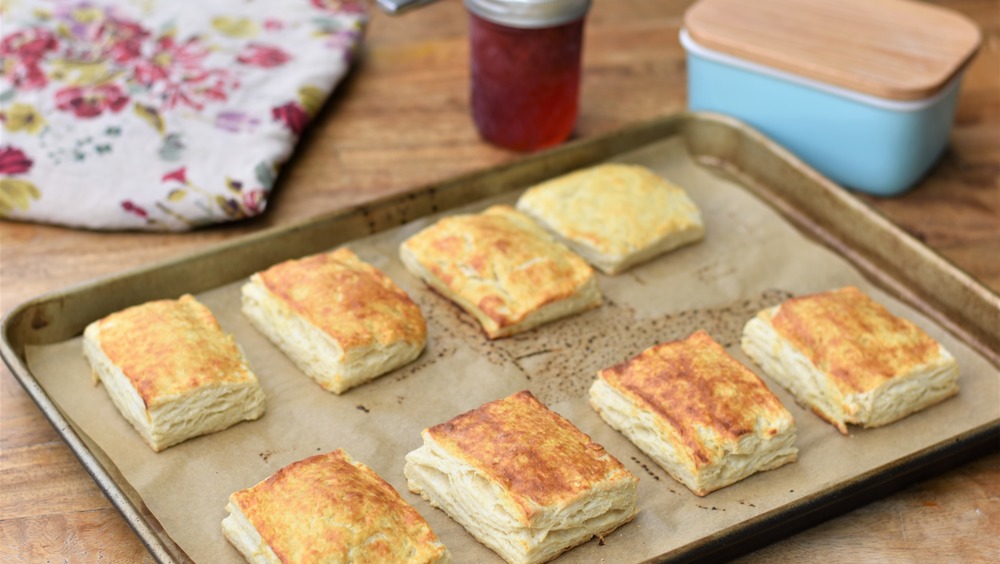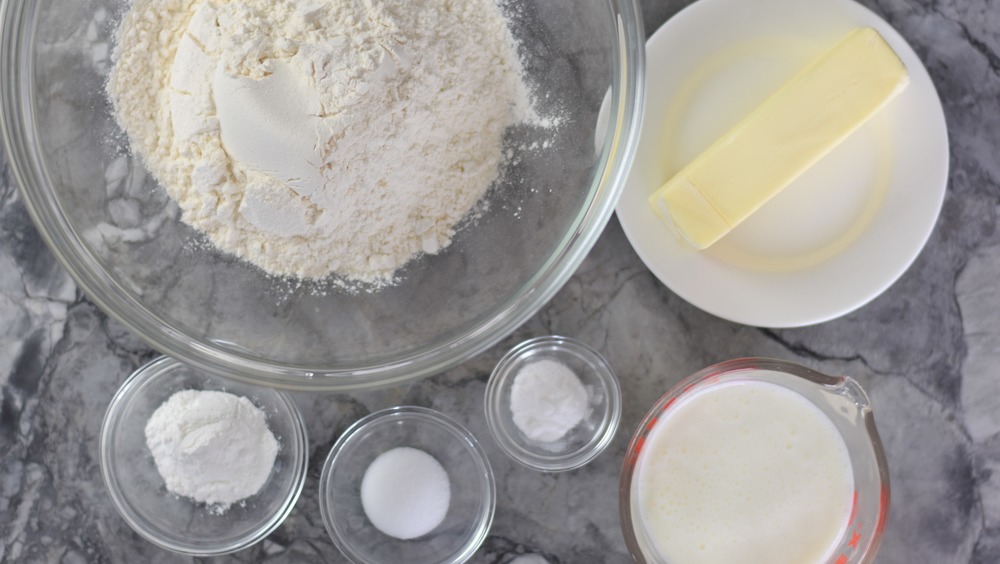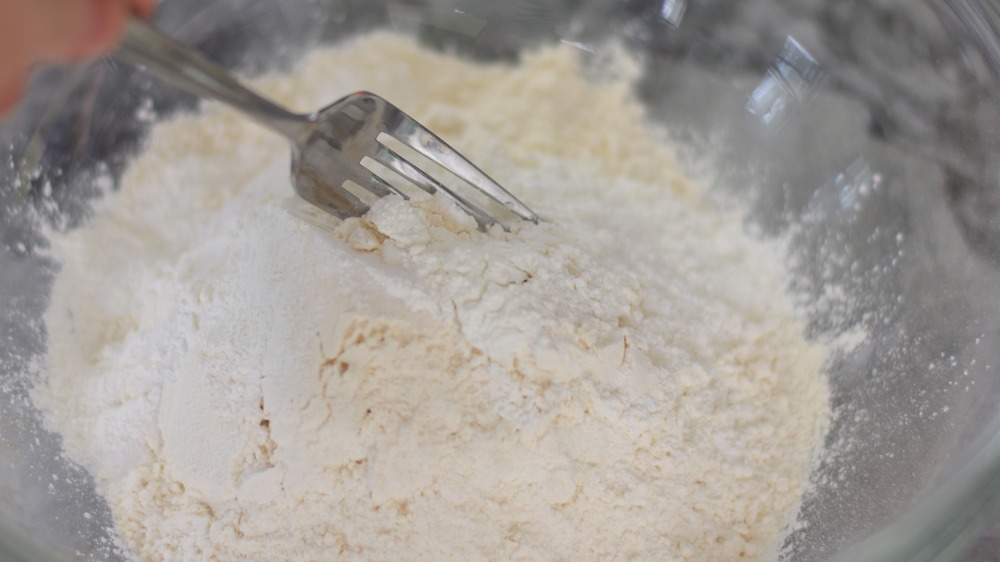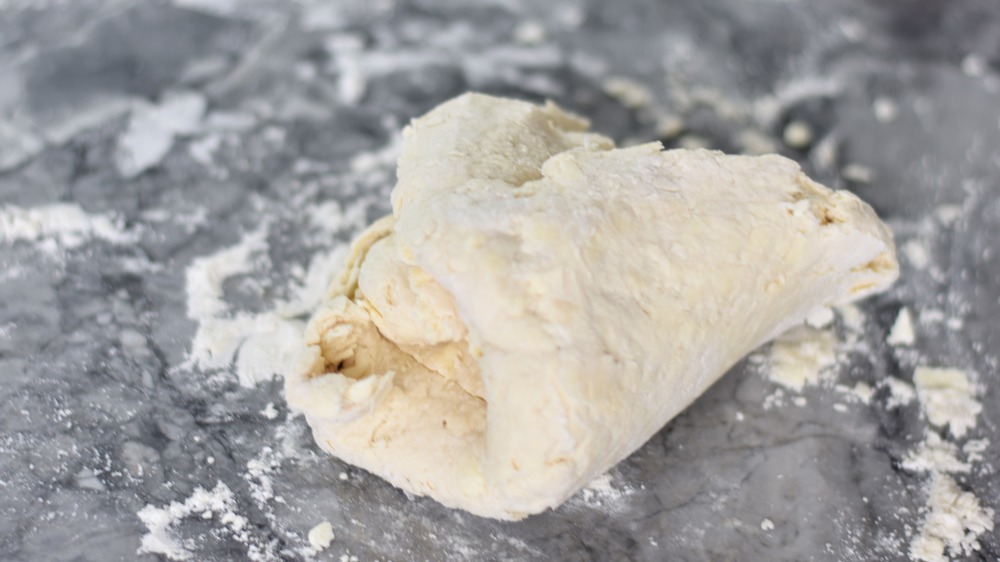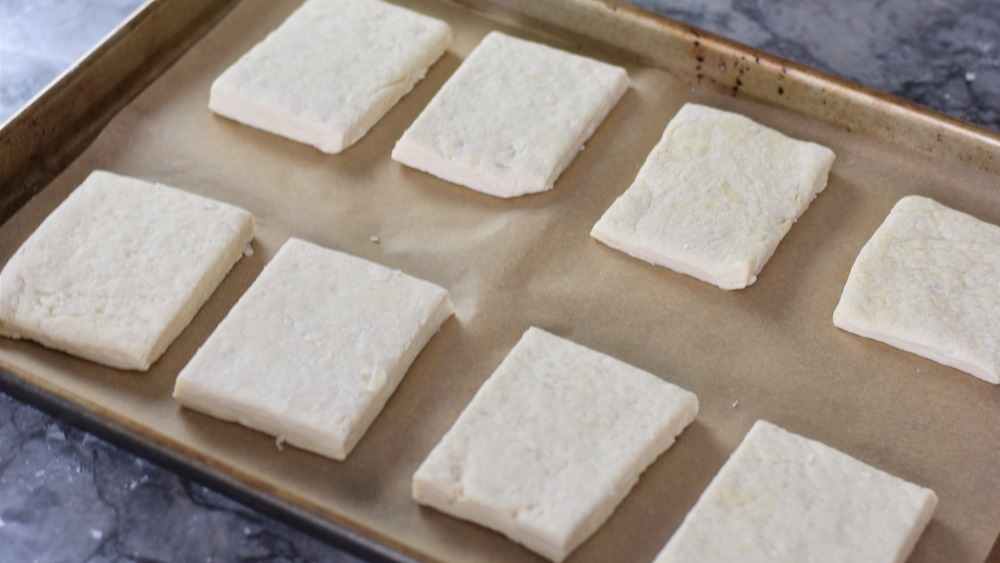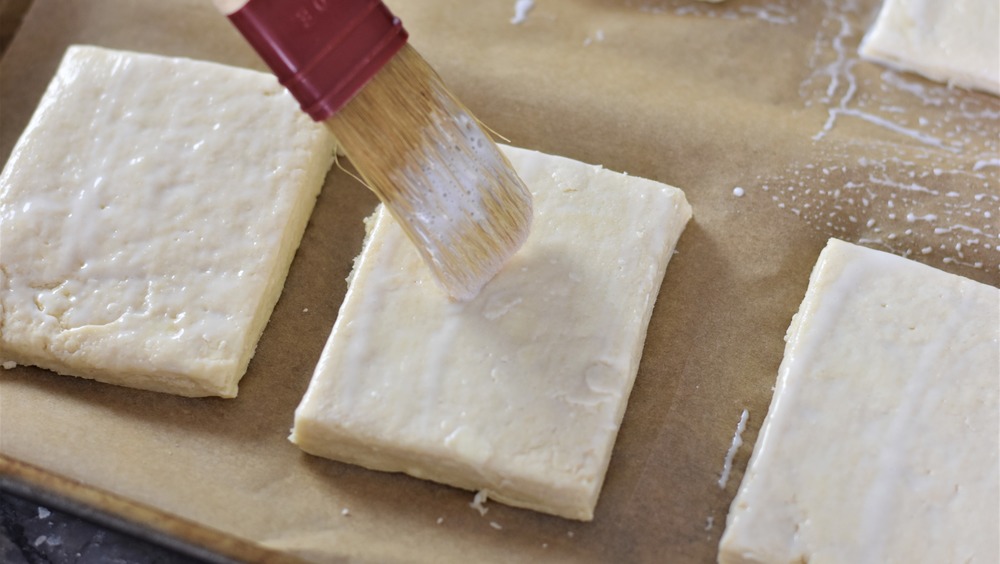Buttermilk Biscuit Recipe
Try to think of a time when you wouldn't love a fresh buttermilk biscuit. Seriously, not rhetorically, try to think of one. Breakfast time and you have bacon and eggs? Add a buttermilk biscuit for the win. Chicken sandwich for lunch? Guess what will make that taste better? Yep. Biscuit. Just got some great news at work? Celebrate with a tasty biscuit! Just got fired? A delicious biscuit will help soothe the sting.
Chef and food writer Stephanie Rapone of Pantry to Plate's favorite way to serve these biscuits is "as a breakfast sandwich with sausage, egg, and cheese or with jam or with honey and butter" but she says they are also great "with sausage gravy." You really can't go wrong serving these rich, flaky, delicious biscuits, and provided you mind a few of Rapone's tips, you really can't mess the recipe up, either.
First tip? "Make sure to have fresh baking powder. If you aren't sure if yours is fresh," she says, "it's probably time to replace it."
Gather your buttermilk biscuits ingredients
As with many baked goods, the secret here isn't so much in the ingredients and is all about how you handle them. You'll need 2 cups of all-purpose flour (plus more for dusting your work surface), 1 tablespoon plus a teaspoon of baking powder, a teaspoon of salt, a half teaspoon of baking soda, a stick (aka eight tablespoons) of unsalted butter, and 1 cup and 2 tablespoons of buttermilk, divided.
As for the special handling, start with the butter. Remove all but 1 tablespoon's worth of the wrapper (leave an eighth of the stick wrapped, e.g.) and then place the stick of butter on a plate or in a bowl and put in the freezer. (The bit of wrapper left on will be for gripping the butter, FYI.)
Now measure 1 cup of the buttermilk and it leave in the fridge until it's needed. Finally for the pre-prep step, move an oven rack to the highest level that still allows at least 5 inches of clearance from the rack to the top of the oven, and then preheat oven to 400º F.
Mix the buttermilk biscuit dry ingredients then add the wet
Place the all-purpose flour, baking powder, iodized salt, and a quarter teaspoon of baking soda in a medium-sized bowl and use a fork or whisk to combine it all well.
Now take the butter from the freezer and, using the large holes on a grater, grate the unwrapped seven tablespoons (remember the wrapped end is simply your handle) into the dry ingredients. Use a fork to stir this mix together without too much force, keeping the butter in the small pieces.
Next, slowly pour the one cup of chilled buttermilk into the butter and flour mixture, stirring with a fork until it becomes a shaggy mix.
Roll out the buttermilk biscuit dough
Dust your work surface with flour (use a marble or granite counter, if possible, as it will help the dough stay colder). Now dump the mixture out of the bowl, then flour your hands and use them to form the shaggy bits into a mound.
Dust a rolling pin with flour and roll the mound out to about 2 inches thick, just enough that you can fold it over onto itself. Fold the dough over, turn it a quarter turn, and then roll again.
Now grab the extra shaggy bits and put them in the middle, fold the dough over the bits, turn it one-quarter again, and roll again. Repeat this process two or three more times (four or five total), until the dough is a single mass and all the shaggy bits are incorporated into the dough.
And do "make sure to roll it with a rolling pin and not just press out with your hands or fingertips," says Rapone. "It makes a huge difference."
Cut out the buttermilk biscuits
Roll the dough a little thinner (about an inch and a half) and fold the outer sections into the middle (like folding a letter), then roll out again, turn, and fold in. Repeat this process three more times. This process of folding and rolling creates layers of butter and flour that result in flaky biscuits.
Finally, roll the dough out to half-inch thickness. Cut biscuits using a biscuit cutter, a knife, or even a bench scraper, that has been dusted with flour. If you use a knife or a bench scraper, make sure to cut the borders off the dough so that every edge of the biscuit has been cut. No matter what you use to cut, use a straight up and down motion (do not twist, drag, or saw through the dough) so that the flaky layers are open and the biscuit can rise properly. You can reassemble and roll the scraps, cutting again, until the dough has all been used.
Chill, brush, then bake the buttermilk biscuits
Put the biscuits on a baking sheet, preferably lined with parchment or a silicone baking mat (if you have it; it's not a requirement), and then place the sheet in the freezer for five minutes.
While the biscuits are in the freezer, mix up the last 2 tablespoons of buttermilk and the rest of the baking soda in a small bowl. When the biscuits come out of the freezer, brush their tops with the buttermilk and baking soda mixture all over the tops.
Now bake them for 12 to 15 minutes, until golden. Let them rest for five minutes after removing them from the oven and enjoy!
Buttermilk Biscuits
Whether it's holding a breakfast sandwich together or smeared with butter and jam, buttermilk biscuits are always a hit. Ready to make some? Let's get started.
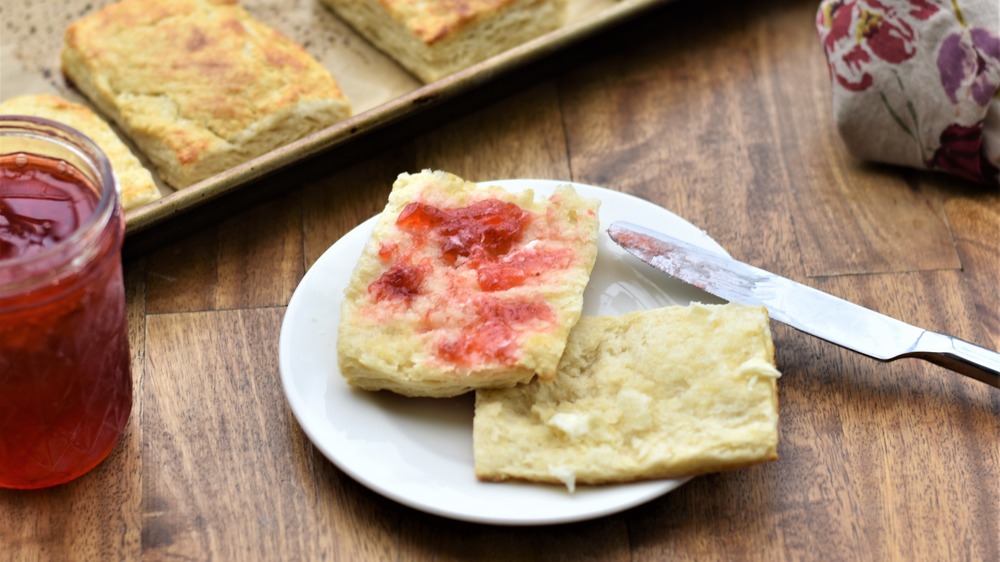
Ingredients
- 2 cups all-purpose flour + more for dusting your work surface
- 1 tablespoon + 1 teaspoon baking powder
- 1 teaspoon iodized salt
- ½ teaspoon baking soda, divided
- 1 stick (8 tablespoons) unsalted butter
- 1 cup + 2 tablespoons buttermilk, divided
Directions
- Unwrap all but 1/8 of a stick of butter (score wrapper with knife for easy peeling) and place butter on a plate or in a bowl and put in the freezer.
- Move the oven rack to the highest level that still allows at least 5" of clearance from the rack to the top of the oven. Preheat oven to 400º F.
- Place all-purpose flour, baking powder, iodized salt, and ¼ teaspoon baking soda in a medium-sized bowl. Use a fork or whisk to combine well.
- Using the large holes on a grater, take the butter from the freezer and grate the unwrapped 7 tablespoons (the 1 tablespoon that is still wrapped is simply your handle). Add the grated butter to the dry ingredients and use a fork to stir together, keeping the butter in the small pieces.
- Slowly pour the 1 cup buttermilk into the butter and flour mixture, mixing with a fork until it becomes a shaggy mix.
- Dust your work surface with flour (use marble or granite if possible, it will help the dough stay colder). Dump the mixture out of the bowl. Flour your hands, and use them to bring the shaggy bits into a mound.
- Dust a rolling pin with flour and roll the mound to about 2" thick. Just enough that you can fold it over onto itself. Fold it over, turn one-quarter turn, and roll again. Grab the extra shaggy bits and put them in the middle. Fold the dough over the shaggy bits, turn one-quarter turn and roll again. Repeat this process 2-3 more times until the dough is a single mass and the shaggy bits are incorporated into the dough.
- Roll the dough a little thinner (about 1 ½") and fold the outer sections into the middle, then roll out again, turn, and fold in. Repeat this process 3 more times.
- Roll the dough out to ½" thickness. Cut biscuits using a biscuit cutter, a knife, or even a bench scraper, that has been dusted with flour. No matter what you use to cut, use a straight up and down motion so that the flaky layers are open and the biscuit can rise properly. You can reassemble and roll the scraps, cutting again, until the dough has all been used.
- Put the biscuits on a baking sheet, preferably lined with parchment or a silicone baking mat and place it in the freezer for 5 minutes.
- While in the freezer, mix up 2 tablespoons of buttermilk and ¼ tsp baking soda in a bowl. When the biscuits come out of the freezer, brush the tops with the buttermilk and baking soda mixture.
- Bake for 12-15 min, until golden. Let them rest for 5 minutes after removing from the oven.
Nutrition
| Calories per Serving | 184 |
| Total Fat | 9.7 g |
| Saturated Fat | 6.0 g |
| Trans Fat | 0.4 g |
| Cholesterol | 25.5 mg |
| Total Carbohydrates | 20.8 g |
| Dietary Fiber | 0.7 g |
| Total Sugars | 1.4 g |
| Sodium | 262.3 mg |
| Protein | 3.6 g |
